by Hema and Eric Bulmer copyright 2003-2020
Click here for More Experiments
To observe Newton's 3rd Law of Motion (Action/Reaction) in cool new way! This is a great experiment to perform after a snack!

Water should shoot out of the holes and cause the juice box to spin until the water runs out.
When you let go of the holes in the juice box, the water rushes out—that is a force. As the water leaves the carton, it pushes back on the carton with a second, equal force, just as the fuel burning out of a rocket propels it forward.
Look carefully at where the holes in the bottom of the box are located. Are they on the same side? Opposite sides? Would this experiment work differently if both holes were on the same side of the box?
Wow! The unshaken can wins every time! This is because shaking the can knocks loose any bubbles sticking to the inner surface of the can. This causes the mass of the soda inside the can to be more evenly distributed throughout the can, causing it to roll more slowly. The unshaken can's soda is (just a little tiny bit) more concentrated around the can's axis of rotation (it's center), and therefore rolls a little bit faster.
There is a famous demonstration using a stool with a spinning seat. If you have one, you can try it. Spin on the stool with your arms held straight out. While spinning, pull your arms in tightly to your chest. Your spinning-speed will increase quickly!! It's the same idea. The closer your mass is to your center, the faster you spin.
To observe Grape Juice's natural ability to detect acids and bases.
KEEP TRACK OF WHICH CUP IS WHICH!
Grape juice detects acids by turning a very light color! And as you may have noticed, baking soda and citric acid react in an exciting way also.
Grape juice, like many other natural chemicals, reacts when different types of chemicals are mixed with it. Cabbage juice is another example of a natural acid/base indicator.
Do you think toothpaste is an acid or a base? How could you find out? What other chemicals could you test with your Grape Juice indicator? With mom or dad's permission & help, design and experiment and try it out!
Kids and teachers alike seem to really enjoy our School Program: "Science Asks Why", but it's always the last demonstration that gets them the most excited, and although I certainly did not invent the famous "Diet Coke & Mentos" experiment, I most definitely have perfected it, resulting in round, brown spots on the ceilings of many Rhode Island Elementary School Auditoriums. After the program, I'm almost always asked how I get this particular demonstration to work so well.

I'll skip over the science behind why this experiment works at all, and tell you the simple secrets to getting a great geyser every time. Use these simple methods and you'll easily get 30 foot plumes of soda flying into the air (without any special restriction device screwed to the top of the bottle) to the delight of any kid (or adult) who happens to be watching.
1. Use Diet Pepsi instead of Diet Coke. Odd, I realize, to perform the famous "Diet Coke & Mentos" experiment without Diet Coke. Truth be told, they both work - but I've used both extensively, and I consistently find Diet Pepsi to work just a little bit better - so why not use it instead?
2. Heat the Soda (without opening the bottle, of course). Get a nice big pitcher - a one gallon size is great - and put your unopened bottle of soda in. Then, fill the pitcher with the hottest water you can get to come out of your sink (DON'T heat water on the stove and use that, please! There's hot and then there's just too hot). Let that bottle sit in the hot water bath for a good twenty minutes and I guarantee maximum altitude.
3. Figure out a good, dependable delivery system to drop the Mentos into the bottle as quickly as possible. I use a Giant Test Tube (sometimes called a 'Baby Soda Bottle', but that's a whole different article). You might use one too, or you might use a rolled up piece of cardboard.
4. When you "blast off", do it from a table top, such as a picnic table. Or put the bottle of soda on top of a wall. Whatever, anything to get it launching from just a bit higher than the ground. Launching from the ground isn't bad, but if you want spectacular results, give yourself a height advantage! 3 feet higher is, after all, 3 feet higher! The more kids have to bend their necks to see the top of the plume, the cooler they will think you are.
CAUTION: THIS EXPERIMENT IS TO BE CONDUCTED ONLY WITH ADULT SUPERVISION!
What, if anything happened when you placed the second wire into the water? Nothing, right?
CAUTION: AT NO TIME SHOULD THE TWO ENDS OF THE WIRES IN THE WATER BE ALLOWED TO TOUCH. If they do, you're setting up a 'no load' or 'short' circuit and the wires and battery will begin to heat up.
Did anything different happen this time (if it didn't, add more salt - amount needed will vary based on the size of your container)?
Despite its bad reputation from movies and TV, fresh water does not really conduct electricity well, as you observed from Part One of our experiment. When Salt is added to water, it dissolves into ions of Sodium and Chlorine, which conduct electricity very well indeed! The gross stuff that started to form in the water (starting out yellow and turning green if you watched long enough) is Sodium Hydroxide (also known as Caustic Soda or Lye), a major ingredient in soap!
Sodium Hydroxide is made of Sodium, Oxygen and Hydrogen. The Sodium comes from the salt. Where does the Oxygen and Hydrogen come from? (HINT: Think about the chemical formula for water).
To make the reaction a bit more noticeable, try wrapping a small strip of aluminum foil around the end of the black wire that goes into the water.
What Happened?
What happened this time?
Parents: Read through this before performing this experiment!
To create a fun-to-play with polymer
Put a funnel into one of the beakers (or an empty jar, if you don't have a beaker). Roll the slime into a nice, round ball and plop the ball into the funnel. Observe the funnel/slime setup every ten minutes or so. Does anything change?
Mixing with Borax causes the glue to polymerize, or convert into an amorphous ("shape changing") solid. Since this is a chemical change, the slime cannot be converted back into glue.
Caution: Do not leave slime on carpets, furniture or anything made of cloth, as it may stain such items. Only play with it on hard, smooth surfaces! Hot water will dissolve hardened slime.
* If you don't have a marble handy, the experiment can also be performed with two balls of clay; one smaller, one larger.
Even though the clay ball is heavier than the marble, you can use the marble to support the ball by holding the spool and spinning the marble around like a lasso. Practice lifting the clay ball by "marble spin power". Can you make the clay ball stay at a constant height? Try it!
Use your head when doing this experiment. An ounce of prevention and all that.
1. File off the edge of a 1982 or later penny. You'll see the silvery zinc underneath. Drop the filed penny into a small glass with hydrochloric acid in it (get some Muriatic acid from the paint store - it's something like 37% HCl). BE CAREFUL with this stuff, it's very caustic.
2. You'll see the penny bubbling away as the zinc and HCl react. The copper won't react with the HCl, however. Let the penny bubble until it stops (mine took about 90 minutes). Run the water in your sink at full blast and SLOWLY decant the acid out of the glass and into the sink. Use a metal strainer if you can't pour slowly enough to prevent your penny-copper-foils from pouring out. DON'T add water to your acid in the glass. That's bad.
3. Rinse the penny foils thoroughly and check them out! COOL!
To amplify sound waves using very simple equipment.
What we're doing here is amplifying sound—producing the sound the string would make anyway, but making it louder. All sound comes from vibration. Here, the string is vibrating, and that gets the air inside the cup vibrating. The shape of the cup helps to amplify the sound. HONK!
Different materials can do a better job of amplifying sound waves. What do you think would happen if you tried this experiment at home with a tin can instead of a paper cup? Try it with Mom/Dad's help!
To observe (with your ears) the difference in sound transmission in air and in a solid object (like your head).
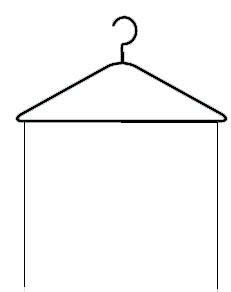
Sound is a form of mechanical energy, and travels in waves. Waves of sound, however, must travel through something in order to be heard (sound cannot travel through a vacuum). Sound travels much better through a solid (like your head) than it does through a gas (like the air).
Do you think changing what the hanger is made of will change the result? Try it with a plastic or wooden hanger.
To make an egg float in water and explore the concept of density

Does the egg float? If yes, congratulations! If no, repeat steps 4 & 5 until the egg floats.
As the salt dissolves in the water, the water's density increases. At first, the egg is more dense than the water, so the egg sinks. Adding salt makes the water more and more dense. When the water finally becomes more dense than the egg, the egg floats!
Think and Talk About This!
To observe the effects of gravity on two objects of different mass.
Gravity pulls the washers down, and the string pulls the paperclip sideways—but gravity also pulls the paperclip down—so its sideways motion is combined with its downward motion!
Would objects with different weights (on either end of the string make a difference in this experiment? Try it at home and find out!
To observe a physical change by using a Paper Chain



You've simply changed the shape of the paper in a clever way. It's still paper, though, isn't it?
Physical changes don't produce a new substance. Chemical changes do. How could you chemically change the paper?
Because Love is never an exact science!
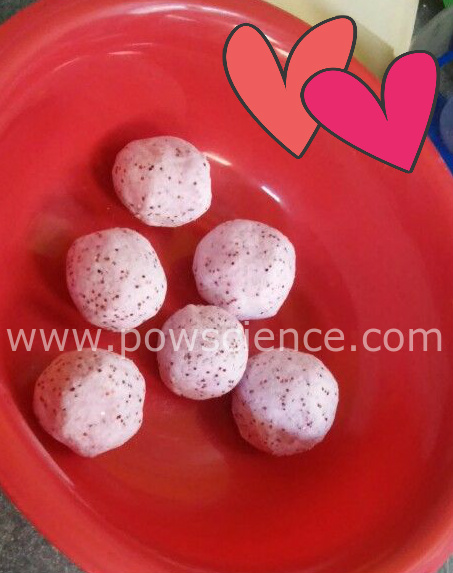
These are great fun to drop into a beaker of water and observe the crazy fizzing or to add some freshness and fun to a bath!
If you're like me, you were excited to see the "Track Builder" Rocket Launcher Accessory - it's a neat gadget that attaches to your track: when a car speeds through the gate, ~POW!~ (pun intended) the Rocket Launches. Neat! Well, almost. I was shocked to learn that "modern" Hot Wheels Orange Straight Track (typically sold by the piece, about 21 inches long) is not "out of the box" compatible with the Rocket Launcher Accessory!
That's terrible! Mattel has been making Hot Wheels Track for decades, and though designs have changed slightly, they've always kept it compatible. In other words, Track Pieces, Loops, Curves from the original 1960s Redline series all fit with the Track Pieces, Loops, and Curves manufactured today. Even the Super Chargers are 100% compatible, regardless of when they were manufactured. Now enter "Hot Wheels Workshop Track Builder" accessories - not compatible with the track pieces I've been collecting and using for years?
I say nonsense! Luckily, there is a VERY easy work-around to make your current Straight Track 100% compatible with the Workshop Track Builder Accessories such as the Rocket Launcher and the Triple Blast Alley. The following pictures chronicle both the problem and the easy solution.
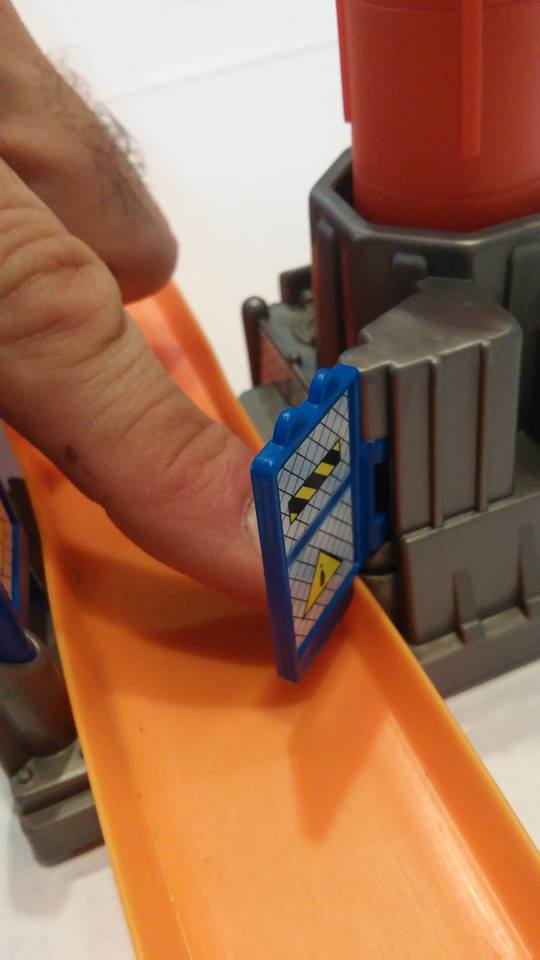
As you can see in the picture above, when the door that launches the rocket is pushed open, if you've installed a modern piece of 21 inch straight track, the door will push against the sidewall and will not swing open fully. The rocket will launch, but the car will crash to a halt every time. No fun!
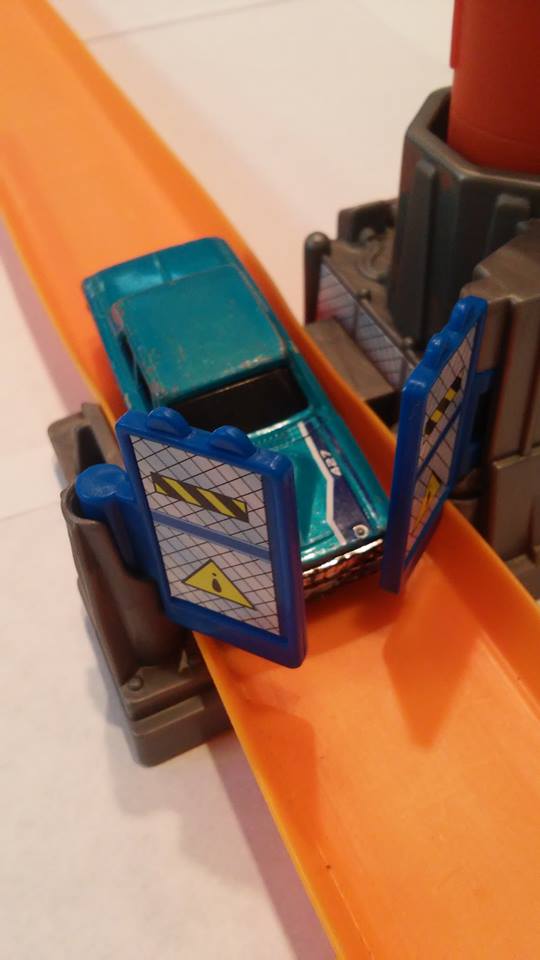
Oh no! As described, this car crashes into the gates, launches the rocket, but slams to a halt, unable to pass through the gate.
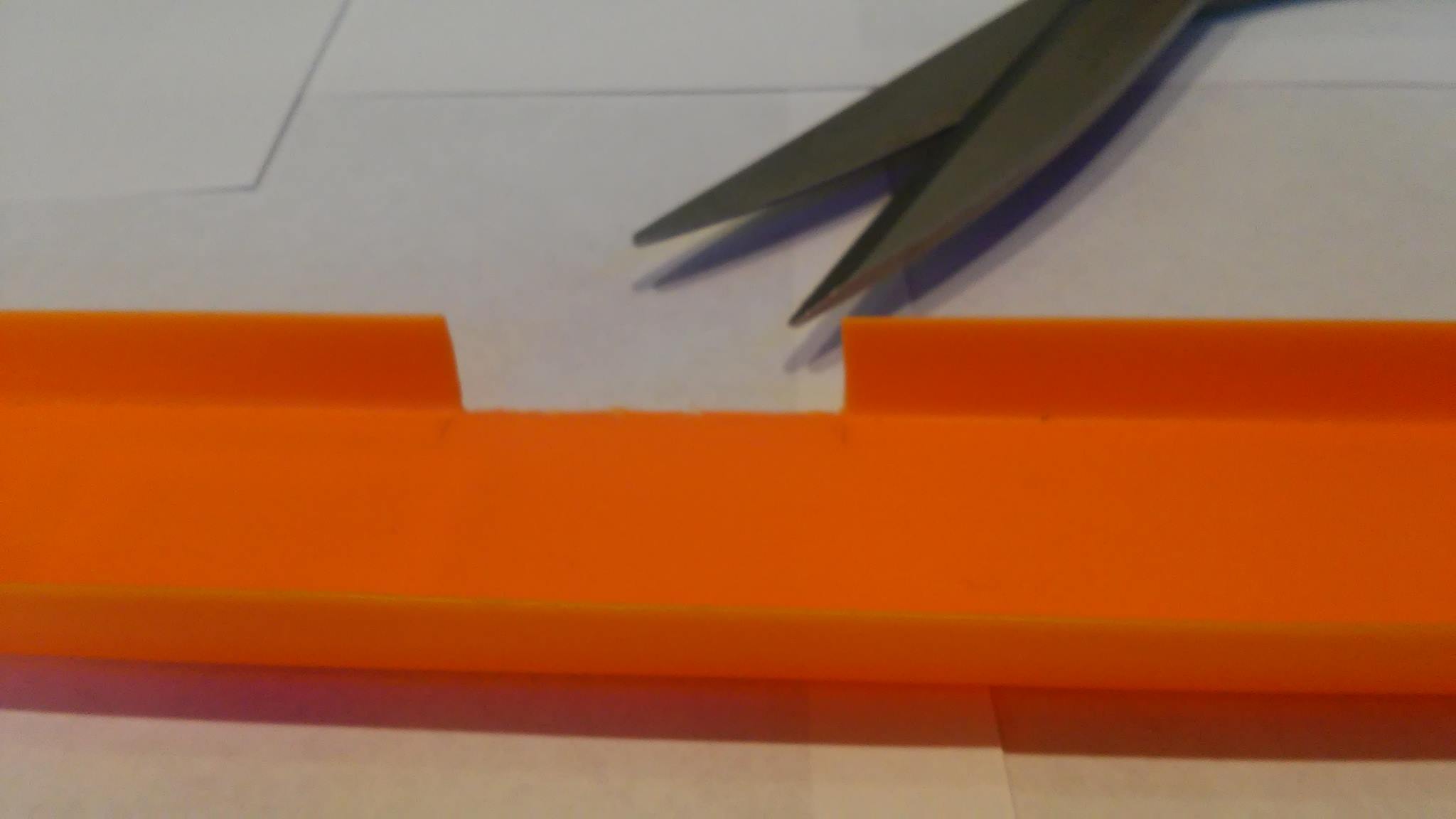
Using a sturdy pair of scissors, I cut away about an inch of sidewall on my straight track.
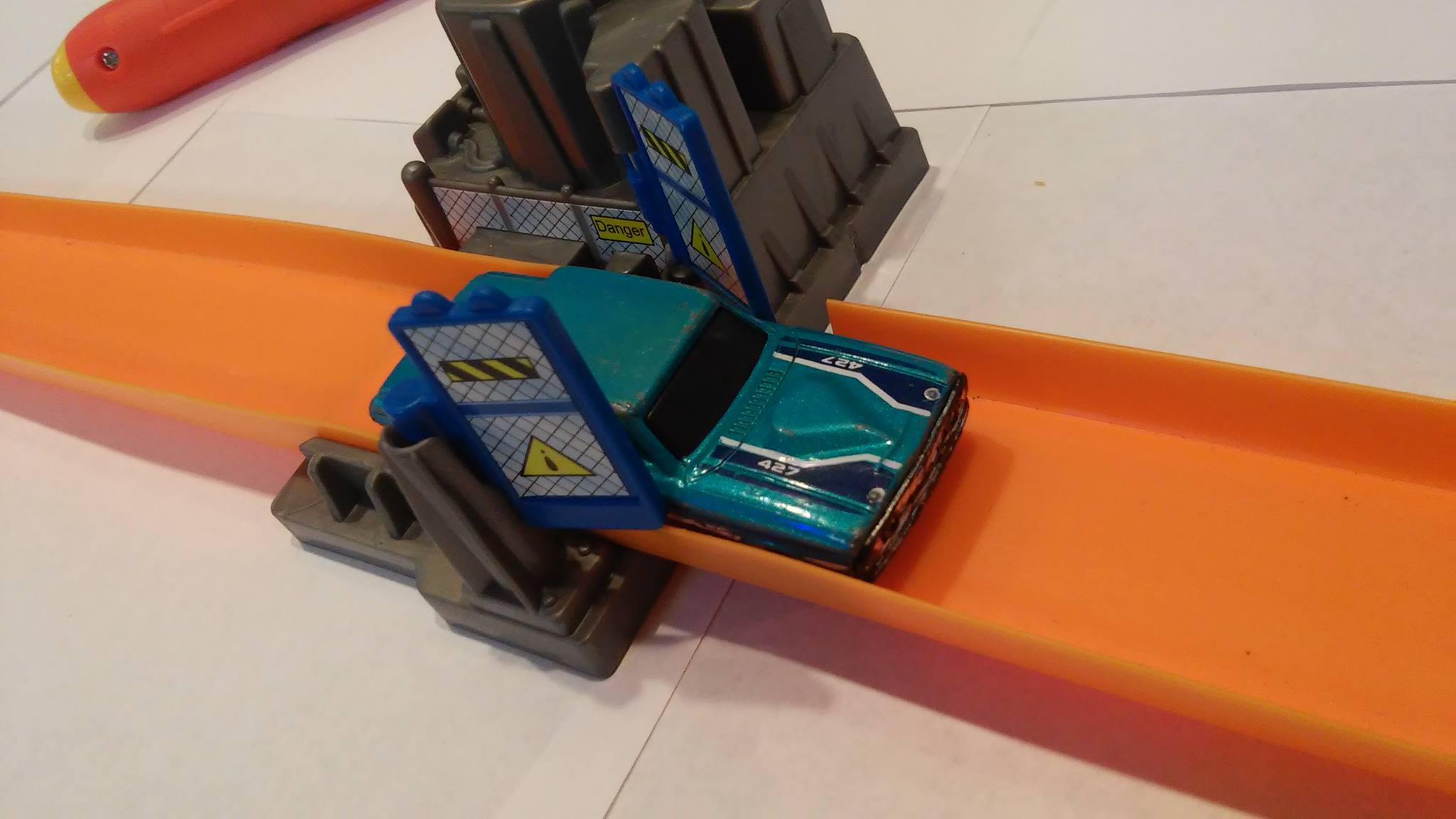
With the sidewall trimmed, the door opens fully and the car passes through, launching the rocket and continuing on its way. Hooray!
I enjoy building elaborate Hot Wheels layouts and do enjoy incorporating these "Track Builder" accessories into my layouts - but I think it's a grave error on Mattel's part to introduce a 2nd type of track into a system that has remained compatible and consistent since being introduced in the 1960s, effectively alienating the collecting/building community.
As a toy store owner, my issue is this: I have no problem trimming a piece of straight track to be compatible with the Rocket Launcher accessory - but I can't expect laymen and/or customers to be willing to do that. It also brings up the "Oh, never mind all of that track you've been collecting for years - now you have to re-do all of your layouts in the 'Track Builder' system." No way. Not this Hot Wheels enthusiast.
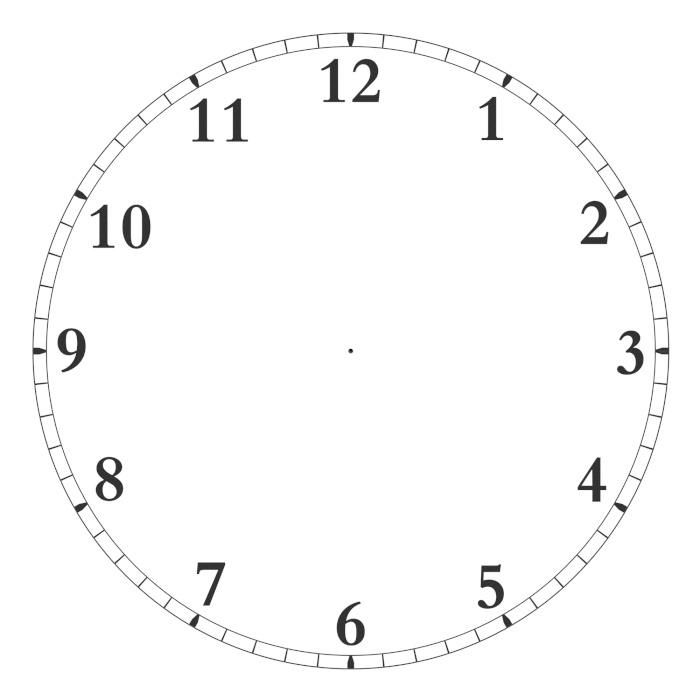
Many kids, including myself when I was young, have very little concept of time or sense of its passing–or at least, not a very well developed sense. I remember my dad asking me to estimate minutes during a car ride as a young nerd…about 6 or 7 years old. I was counting off minutes about every 3 or 4 seconds. Instead of helping me out, Dad pretty much just had a good laugh and drove on.
My 3rd Grade Teacher, Mrs. Churchill, helped us develop a sense of time with a stunningly simple activity. She told us to just sit there with our eyes closed and wait…for one minute. When we thought a minute had elapsed, we should raise our hand. We all low-balled it during our first several attempts, but after not all that many trials, we actually started putting our hands up around the 45 or 50 second mark, maybe the 55 second mark if we were really counting well in our heads. Once I even waited too long and she rang the “minute’s up!” bell before I’d even raised my hand. Sheepishly, I shot it up right at the bell, hoping I’d be lauded as a true master of time….the only one who nailed the minute right to the split-second. Mrs. Churchill was not fooled. But she did teach us how to estimate a minute fairly accurately, and to respect what a fairly large amount of time a minute really is. She had it way up on Dad!
If you’re trying to get your kids to understand time a little bit better, give this activity a try!